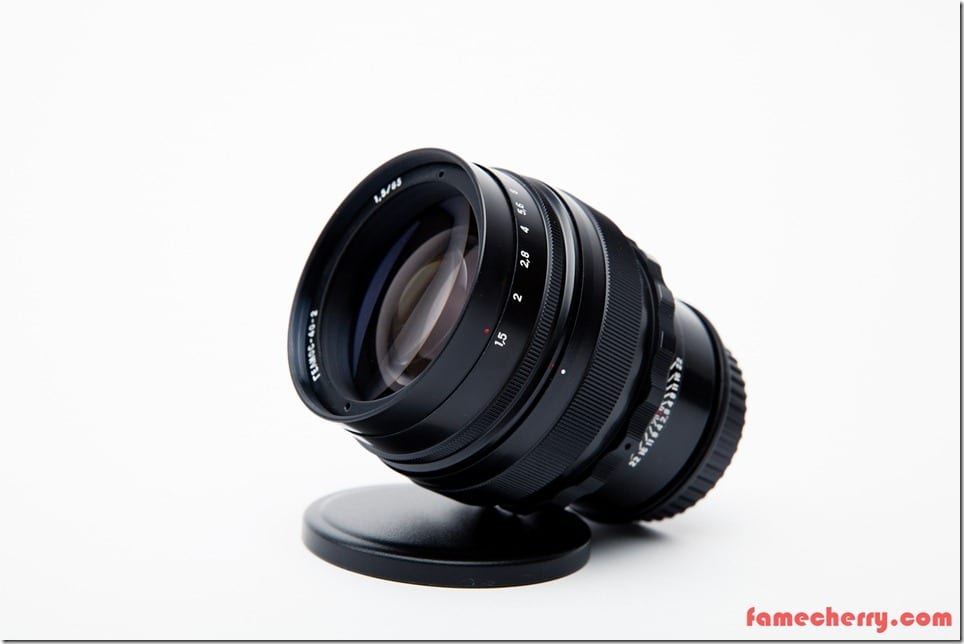Price : RM 1499
Available Mounts : Canon, Nikon, Sony, Pentax, NEX, M4/3, M42, Fuji, Samsung
Special Characteristics : Sharp Even At Corners, Swirly Bohkeh, Precision Aperture Bracketing, Smooth Aperture Ring ( Clickless )
Purchase Options : Shipping Available To All Parts of Malaysia, Self Pick Up Is Available at our branch in Cheras
Sample Photos & Effects : https://www.google.com.my/search?q=helios+40-2
More Sample Photos & Effects : https://www.google.com.my/search?q=helios+85mm+f1.5
Community
Join The Zenit Worldwide Community : https://www.facebook.com/groups/zenit-world
Manufacturer : Zenit
Technology : Carl Zeiss
Focal distance : 85mm
Aperture : F1.5
Field angle, (diagonally the frame) : 28 Degrees
Number of lenses/elements : 6/4
Minimum shooting distance : 0.8 m
Overall dimensions : Ø 82×84 mm
Filter size : 67mm
Weight : 950g
History
Zenit is a Russian (and formerly Soviet) camera brand manufactured by KMZ in the town of Krasnogorsk near Moscow since 1952
Founding and post-war years
After the German invasion of the Soviet Union in World War II, the Red Army had acute need for precision optical instruments. The existing factories were either inaccessible, such as LOMO in besieged Leningrad, or overloaded with demand, such as FED which had just been evacuated from Kharkiv to Berdsk. The KMZ factory was set up in 1942 near Moscow, which by then was no longer in immediate danger from German troops, on the site of a recently evacuated mechanical plant. Initially the company took over production of scopes and binoculars as well as reconnaissance cameras.
After the end of the war, KMZ began producing photographic lenses in 1945 to the specifications of the Carl Zeiss corporation, whose factory in Jena had been overrun by the Red Army and largely carted off as war reparations. In the post-war years KMZ also began producing the Zorki camera, a close copy of the German Leica II and the Soviet FED, as well as copies of Zeiss medium-format cameras under the name Moskva. These mark the beginning of consumer production at KMZ besides the original military focus of the company. During the following years, KMZ was the main supplier of photographic lenses in the Soviet Union.
1950s and 1960s: Years of creativity
The mid-1950s saw the beginning of a period of heightened R&D activity at KMZ. One reason was that lens production could be offloaded to a number of other new optical plants, including Arsenal in Kiev which began producing lenses in 1955. This freed up valuable resources at KMZ. Another reason was the changed economic policy under Nikita Khrushchev, which placed more emphasis on producing consumer goods, such as cameras, instead of investment goods and heavy industry. As a result, KMZ produced several highly interesting concept cameras that won international prizes at fairs such as the 1958 World Exhibition in Brussels.
The company’s Zorki line of rangefinder cameras underwent significant modifications that moved it gradually from being a direct Leica copy towards an original camera line of its own. Several other highly interesting rangefinder camera lines were developed out of the Zorki in the early 1960s and put to market in relatively small numbers. However, the most influential camera developed during this period was the Zenit, a single-lens reflex camera based on the Zorki rangefinder body. The Zenit line was presented in 1953, and of the first generation of Zenit cameras, more than 1.2 million units were produced until the end of the 1960s. A major redesign was presented in 1967 that made the line compatible with the M42 lens mount that was in use worldwide.
In 1965, KMZ also began producing movie cameras, of which was the Krasnogorsk series for 16 mm film was the most well-known. During this time, there was substantial cooperation between the military and the civilian sections at KMZ; an example of this is the Horizont panoramic camera of 1967, which was developed out of an older artillery camera and continues to be produced in modified fashion to this day.
1970s and 1980s: Catering to the domestic market
The pace of R&D for consumer products at KMZ substantially slowed down at the end of the 1960s. One reason for this might have been the relatively low output figures. Since large amounts of resources were channeled towards research and development, production figures itself were low. Under the conditions of the Soviet planned economy, these absolute production figures tended to be the main indicator for a company’s productivity, which made it somewhat undesirable to invest in research and development. Another reason may have been the changed economic policy under Leonid Brezhnev, which again focused increasingly on heavy industry and arms production.
During the 1970s consumer production at KMZ shifted towards producing large numbers of individual, relatively simple models of the existing product lines. These still underwent smaller modifications and innovations, but there was a clear focus on mass production. The Zorki line of rangefinder cameras was continued until 1980 with a single model dating back to the 1956, of which 2.2 million were produced with some modifications. The Krasnogorsk-3 movie camera was produced in a largely unchanged fashion from 1971 to 1989. The Zenit line of SLRs saw somewhat more substantial modifications, such as the addition of light metering, but here too the focus was primarily on mass producing tried-and-true models, rather than implementing technical innovations such as automatic exposure that had been standard in the West for almost a decade before they appeared on the Zenit. To cope with domestic demand, Zenit production was outsourced to several other camera works in the Soviet Union as well. More than 6 million Zenit cameras were produced at KMZ until the end of the 1980s, but by that time the Zenit comparatively outdated. During this time, the relative importance of the military section of KMZ grew, in response to the increasing focus on arms production in the USSR in general. KMZ also developed a major focus in metallurgy, mechanical engineering and optoelectronics.
Demo
Inspiration
Sample Photos & Effects : https://www.google.com.my/search?q=helios+40-2
More Sample Photos & Effects : https://www.google.com.my/search?q=helios+85mm+f1.5






















Is this auto focus lense?
Manual Focus
full manual :) only AF-confirm adapter!
I’m in VietNam and want to get one but don’t know if this is possible?
Nice to meet you ;-)
Pmd
this lense still availlable ? :D
Absolutely =)
Besides the 85mm.. do u hv 100mm f1.5 Helios ? or other Helios lens?
If factory decides to relaunch the oldies but goodies then we will take em up =)
Do u hv the 58mm f2?? a-mount? if yes how much?
do u hv Helios 58mm F2 lens a-mount? how much? i saw the old m42
Sorry bro dont have we only sell new lens
minimum aperture ?
f1.5 – f22
can be use on Nikon without any modification? Mine is Nikon D90
Yes can be used without modification =)
this lense still availlable?
Yes, ready stock =)
brand new?
brand new?
Yes it is
First hand =)
hi, did it come with the mount adapter?example, nex mount adapter?thanks..
Yes it comes together d =)
Do u hv Helios 58mm f2 ?
Do u hv Helios 58mm f2 a-mount?
You got email =)
can i use with my canon eos 650d? :)
Yes u can =)
Btw what is your email address ?
Hi, is this lens for nikon still available? Do i need adapter to connect the lens with nikon d7000? As i am in Netherland, can i still purchase that. Do you provide delivery service here.
U have email =)
Yes can post to you
Thank you
Can i use this lens with my SONY NEX-5R or other SONY NEX models? Do you provide delivery service here? How long the delivery time will be taken until this lense arrive at my house after payment confirmation? :)
Yes can
Yes we can use courier
Usually 1 working day after they pick up from our place ( under normal circumstances )
this lens can focusing detect @ focus confirmation?
Depends on your camera
I cant email you, please contact me at 012-3375629 ( Also available on Whatsapp )
my camera canon 7D. my second email zulssb2@hotmail.com
U got email =)
Hi,
Does it come with x-mount or adapter required? The price include adapter?
All you need is included for all common mounts
U got email =)
Hi there i already send the detail about my purchase on Helios 85mm f1.5 on your email..
Noted with thanks, send out asap
Thank you so much for choosing us ! =D
i m using sony A7 , does it come with e mount or need adapter?
You have email =)
I am coming to KL tonight. Does this lens fit a Canon 7D? Can I pick up at your store Sat or Sun?
You got email =)
Yes can use
Is there AF confirmation adaptor for canon?
U got email =)
how to get AF in 40d? this lens mount on 40d?
U got email =)
Is this native F-mount or m42 with adapters ?
U got email =)
what is the specification of the package for the lens..? I’m sorry, because I’m afraid if this lens will damage or broken when arrive to the address
Thank You
No need afraid of anything, this lens is so tough its practically armored
U have email =)
what about the delivery package..? can you provide a save delivery package for the item
Thanks
Of course
U got email =)
is it need adapter to connect with d7000???? and i’m read it is fully manual right??? but i also heard about af-confirm adapter…. can you give some explaination???
U got email =)
is this lens for nikon still available? Do i need adapter to connect the lens with nikon D800?
Yes got =)
U got email
Hi do you still have this model.Can i use it on Nikon D2X
Ready stock
Yes can use
U got email =)
Sorry one more question. Is this russion made or China made?
100% Russian
hi, is this lens can be both use in nikon d7000 and nikon d50? still available?
U got email =)
Hi FAME Cheri , is this lens for sales ? How to purchase if available for sale ?
U got email =D
Have stock?
U got email =)
Still available for Canon FE mount?
U got email =D
hi. is this still available?
You’ve got email =D
WTB ~ X-mount
thank you
email sent =)
Available?
sorry this one we no longer sell
but i think on ebay u can get pretty good price